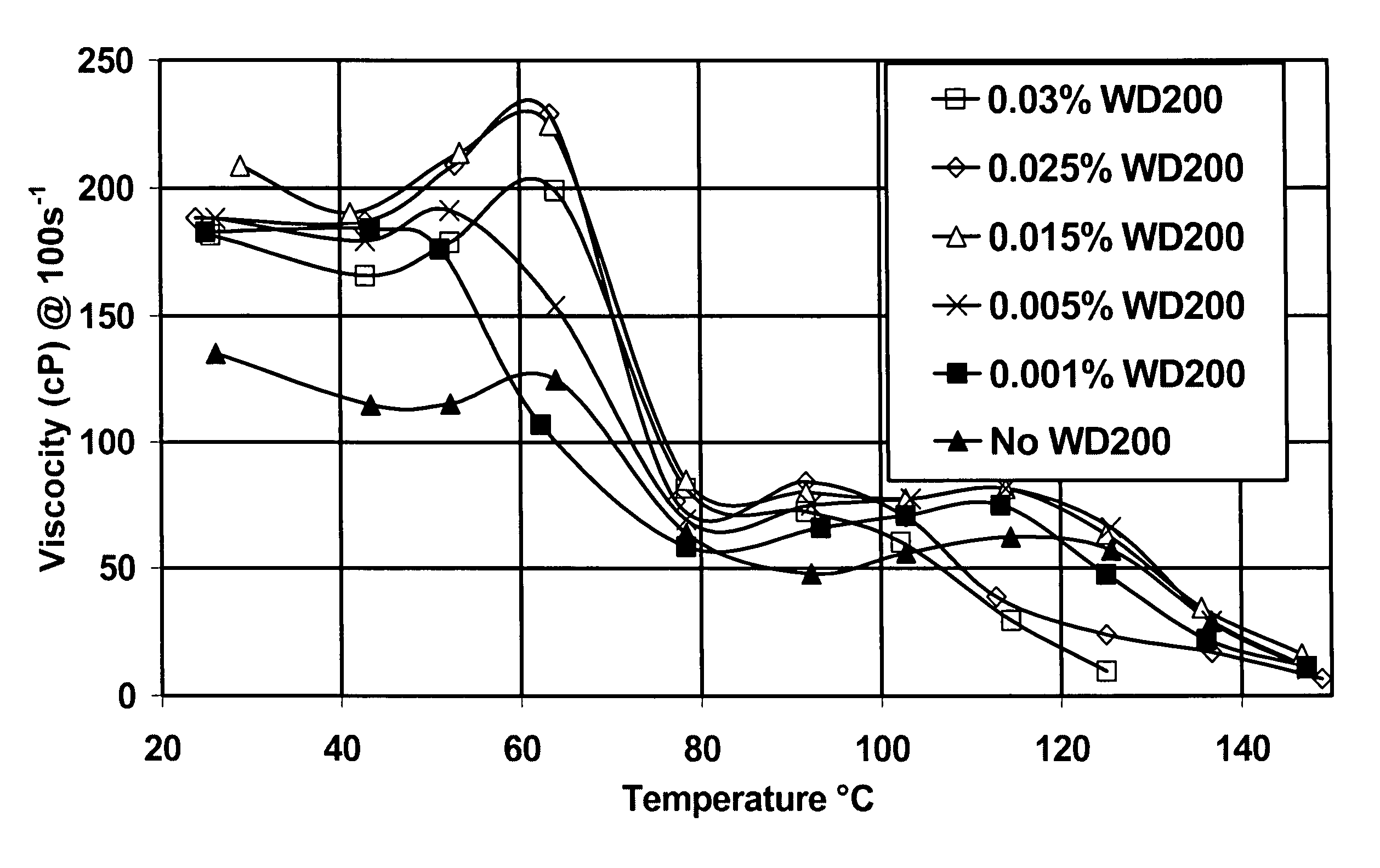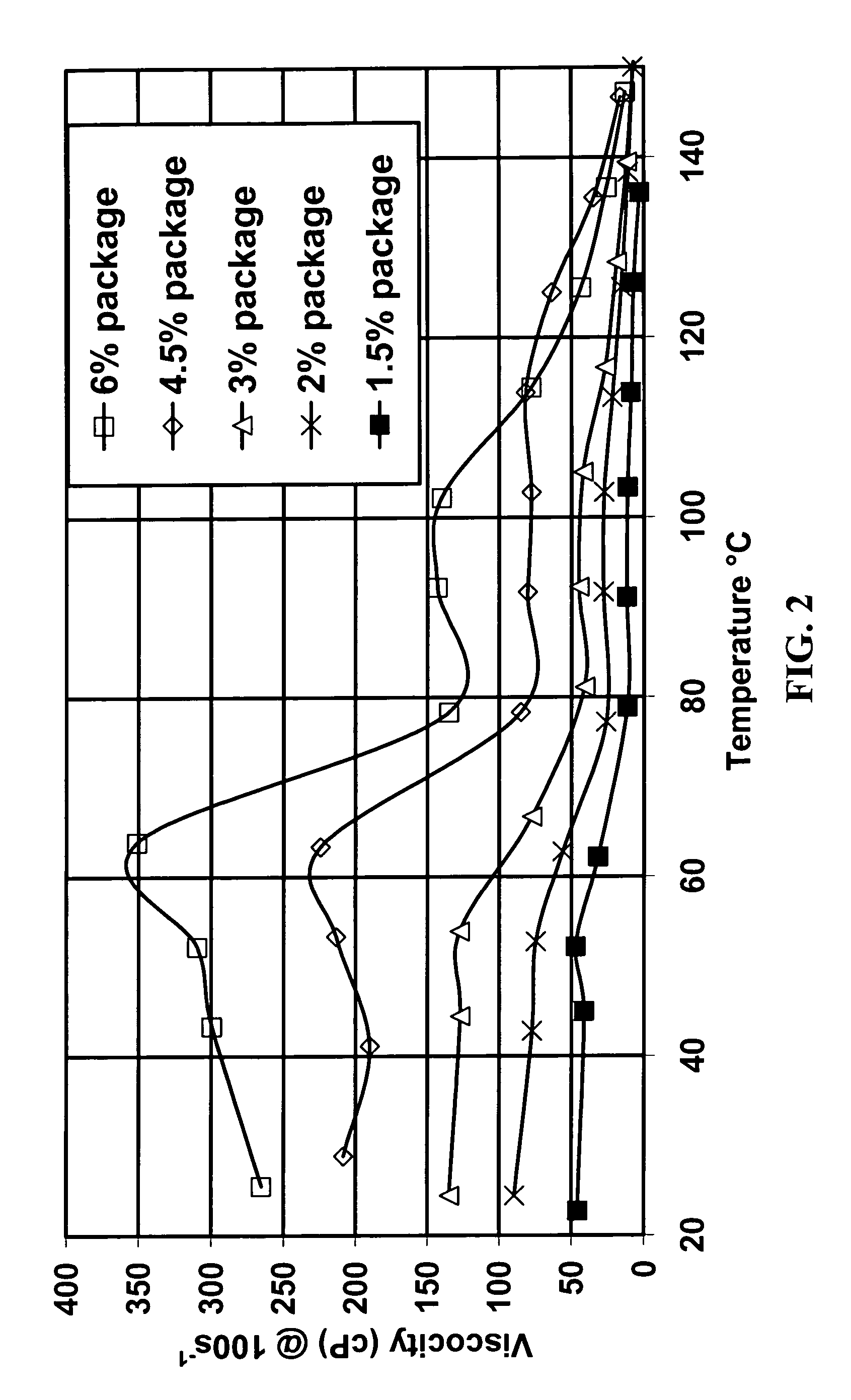Viscoelastic surfactant rheology modification
a technology of viscoelastic surfactants and rheology, which is applied in the direction of detergent compositions, well accessories, sealing/packing, etc., can solve the problems of reduced stability, reduced viscosity, and increased shear sensitivity, so as to shorten the shear recovery time of the fluid, and shorten the shear recovery tim
- Summary
- Abstract
- Description
- Claims
- Application Information
AI Technical Summary
Benefits of technology
Problems solved by technology
Method used
Image
Examples
example 1
[0050]The table below shows the shear recovery times observed when various amounts of WD200 were added to four surfactant systems. In these experiments, approximately 200 mL of already-mixed VES fluid was sheared at no less than 10,000 rpm for no less than 30 seconds and no more than 1 minute in a 1 L Waring blender. The shearing was stopped and timing was begun. The fluid was poured back and forth between a beaker and the blender cup and the fluid recovery was characterized by two times, referred to as the initial and final recovery times; both were estimated by visual observation. The initial fluid recovery time was the time at which fluid “balling” occurred (when the fluid showed the first signs of elasticity as indicated by the fluid taking a longer time to achieve a flat surface in the receiving beaker when poured). The final fluid recovery time was the time at which fluid “lipping” occurred. The fluid “lips” when inclining the upper beaker or cup containing the fluid does not ...
example 2
[0052]In addition to dramatically shortening shear recovery times at very low concentrations, the rheology enhancer of the invention also increases fluid system viscosity. Varying amounts of WD200 were added to fluids made with 4.5% of as-received surfactant concentrate Zw A without added salt. The viscosity measured with a Fann 50 at 100 sec−1 was measured at various temperatures. The results are shown in FIG. 1. At low temperatures, the viscosity was increased by all concentrations of WD200 tested. At higher temperatures, the higher WD200 concentrations lowered the viscosity (although they still shortened shear recovery time). For this concentration of this surfactant, about 0.015% of this rheology enhancer is optimal for increasing the viscosity over the entire temperature range. For other surfactant / rheology enhancer combinations and other surfactant concentrations, the optimal rheology enhancer concentration may be different. Similarly, if optimization at a certain temperature ...
example 3
[0053]Because the rheology enhancer of the invention is suitable over a broad range of conditions, it is advantageous to prepackage a concentrate containing a viscoelastic surfactant and a rheology enhancer (or more than one of each) at a fixed concentration ratio. FIG. 2 shows the effect of varying the total concentration of one such package (as-received Zw A with WD200 added so that the ratio of active betaine surfactant to WD200 is 300) at varying concentrations.
PUM
| Property | Measurement | Unit |
|---|---|---|
| time | aaaaa | aaaaa |
| weight percent | aaaaa | aaaaa |
| rheology | aaaaa | aaaaa |
Abstract
Description
Claims
Application Information
 Login to View More
Login to View More - R&D
- Intellectual Property
- Life Sciences
- Materials
- Tech Scout
- Unparalleled Data Quality
- Higher Quality Content
- 60% Fewer Hallucinations
Browse by: Latest US Patents, China's latest patents, Technical Efficacy Thesaurus, Application Domain, Technology Topic, Popular Technical Reports.
© 2025 PatSnap. All rights reserved.Legal|Privacy policy|Modern Slavery Act Transparency Statement|Sitemap|About US| Contact US: help@patsnap.com



